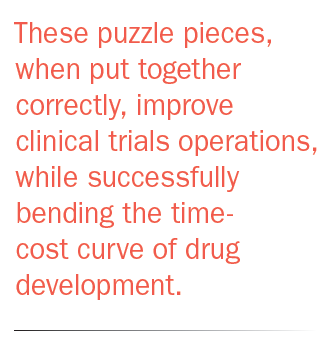Building A Better FSP
Applied Clinical Trials
Outlining the three concerns communicated the most when it comes to implementing an FSP outsourcing strategy.
Functional service provision, provider, and/or partnerships-otherwise known as FSP-is a concept that has been used in the life sciences industry for over 20 years. Even so, the understanding of FSP, how it is evolving, and how to get the best results from the model still are a puzzle to many. For the purposes of this article, we define FSP as an outsourcing strategy where vendors provide a single service (statistics, pharmacovigilance, or clinical monitoring, etc.) or a limited number of highly related services (site contracting, site payments, etc.). Regardless of your definition, clients regularly communicate three concerns with the FSP model: resource forecasting, quality and training of staff, and innovation.
Resource forecasting. The norm for much of the last 20 years has been for sponsors to estimate the number of people needed when, where, and in what roles, and then inform their FSP vendors to provide the needed resources. Forecasting creates a burden on predicting needs, magnified by constant updates to projects, protocols, and priorities. Moreover, there are incentives within companies that can impact the accuracy of resource forecasts.
Sponsors may underestimate or overestimate the number of people they need, an issue that can occur with their own internal hires as well as FSP vendor staff and services. Requesting more resources than needed may be seen as a hedge to reduce the risk of missing operational deadlines. Underestimating scope is incentivized to meet budget targets, at least in the short run. In either case, clients hesitate to ask FSP vendors to forecast

resources, fearing they inflate the scope of services in order to increase revenue.
However, best-in-class FSP providers have become adept at maximizing resource forecasting so as to require fewer resources to deliver a function or task. Therefore, FSP clients should require their vendors to shoulder capacity management, while demanding utilization and performance metrics to verify the FSP workforce is right-sized.
Quality and training. A common concern is that FSP vendors-in an attempt to reduce costs-provide less experienced and qualified people who receive lower salaries and fewer benefits. The net result is cost savings, which are very important, but may be overshadowed by higher turnover, lower quality, repeat work, and operational delivery problems.
In the face of these issues, training and mentoring become even more important. Historically, and particularly so for clinical monitoring FSPs, FSP vendor staff use the client’s systems and processes. Their systems harmonize the way a study or portfolio of studies is conducted around the world, when FSP staff collaborate with client employees and/or staff from multiple vendors. The tradeoff is that sponsors often have to take on the burden of training vendor staff on their proprietary systems and SOPs. This, coupled with the traditionally higher turnover associated with some FSP vendors, magnifies the training burden on customers.
In best-of-class FSP operations, the solution is to use vendor systems and SOPs whenever practicable, but then shift the responsibility of training on client systems and SOPs to vendors using a train-the-trainer model.
Innovation. When using sponsor systems and procedures, FSP vendors are left with little leverage to address process improvement, as any enhancements typically require changes from the client-often at an additional cost in terms of investments in new software, tools, and so forth. As a result, FSP vendors typically place the responsibility for innovation on their clients. Moreover, the traditional full-time equivalency (FTE)-based model for FSP de-emphasizes innovation, whereas moving to unitized models financially incentivizes FSP vendors to do better, faster work with fewer people.
Therefore, best-in-class FSP vendors are moving away from simply providing headcount, to coupling their FSP services with vendor-driven innovation. In clinical monitoring, for example, FSP vendors are providing access to proprietary site networks, risk-based and remote monitoring services, and protocol optimization services as “add-ons.” These innovations drive the need for fewer or less expensive headcount, not more. The intended result may be less revenue for the FSP vendor on a project-by-project basis, but often more satisfied customers and repeat business.


Krystina Fuge, Senior Project Assistant, PPD; Brian Ford, Associate Director, Functional Service Partnerships, PPD

Improving Relationships and Diversifying the Site Selection Process
April 17th 2025In this episode of the Applied Clinical Trials Podcast, Liz Beatty, co-founder and chief strategy officer, Inato, discusses a number of topics around site engagement including community-based sites, the role of technology in improving site/sponsor relationships, how increased operational costs are impacting the industry, and more.
Behind the Buzz: Why Clinical Research Leaders Flock to SCOPE Summit
February 7th 2025In this episode, we meet with Micah Lieberman, Executive Conference Director for SCOPE Summit (Summit for Clinical Ops Executives) at Cambridge Innovation Institute. We will dive deep into the critical role of collaboration within the clinical research ecosystem. How do we bring together diverse stakeholders—sponsors, CROs, clinical trial tech innovators, suppliers, patients, sites, advocacy organizations, investors, and non-profits—to share best practices in trial design, program planning, innovation, and clinical operations? We’ll explore why it’s vital for thought leaders to step beyond their own organizations and learn from others, exchanging ideas that drive advancements in clinical research. Additionally, we’ll discuss the pivotal role of scientific conferences like SCOPE Summit in fostering these essential connections and collaborations, helping shape the future of clinical trials. Join us as we uncover how collective wisdom and cross-industry partnerships are transforming the landscape of clinical research.


















